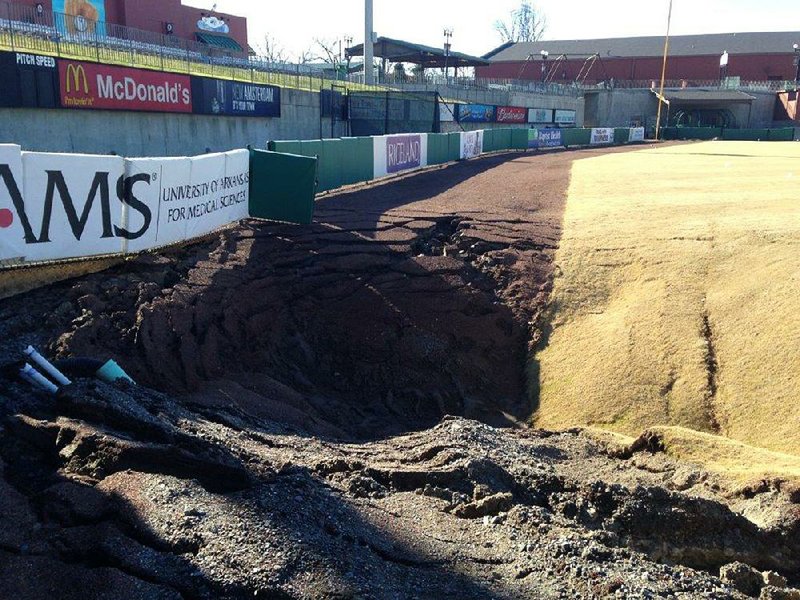Work to repair numerous sinkholes at Dickey-Stephens Park in North Little Rock is to begin today after the City Council's approval Tuesday to waive competitive bidding and allocate $375,000 toward fixing the Arkansas Travelers' home field.
Sinkholes began appearing in December after heavy rains and flooding along the Arkansas River, city officials have said.
"They're all along the outfield," Chief City Engineer Chris Wilbourn said just before the City Council's special meeting to address the sinkhole problem. "We start in earnest [today]. We won't know exactly what we have until we dig it out.
"It's a groundwater problem," he added.
The largest sinkhole on the center field warning track is about 35 feet in diameter and 6 to 7 feet deep, Wilbourn said.
Estimated cost for the project is $341,247.52 plus a 10 percent contingency, totaling $375,000, according to city Finance Director Karen Scott. The legislation passed Tuesday contracted with Diamond Construction Co. of North Little Rock to make the repairs for $178,647 in labor and equipment. The city is purchasing all materials at an anticipated cost of $162,600.
The money is to come from adding the $375,000 to the city's Sales Tax Capital Improvement Fund budget, which is comprised of one-quarter of the annual city sales tax revenue, Scott said. The initial funds used will be $88,000 from the North Little Rock Public Building Authority and $287,000 from carryover funds from the previous city budget.
The city-owned, $40.4 million ballpark, 400 W. Broadway, is on the north side of the city's Riverfront Drive and on the east side of where the Broadway Bridge crosses the river from Little Rock into North Little Rock.
The Class AA Minor League Travelers begin their home season in the ballpark April 7.
The ordinance to approve the work, passed in an 8-0 vote, calls for a 44-day work schedule, but Wilbourn told the council that the job has to be completed earlier. The bulk of repairs, including rehabilitation of 600 feet of drainage pipes, must be done in time for other uses of the ballpark and for field preparation for the Travelers' season, he said.
"We have a set date for when there will be the first use of the field," Wilbourn said. "We will work backwards from that date. From right now, we don't have 44 days. That would go past the timeline they [Diamond Construction] have to be out of there.
"We may not be able to finish all of it before the start of the season," Wilbourn said. "I am confident that we will finish the really serious areas by then."
The ballpark's playing field was built 12 feet below street level. The ballpark opened in 2007. A 5-yard-wide sinkhole appeared the next year in the outfield, and other, smaller sinkholes have appeared and been filled during subsequent years, including after the river swelled last spring.
"Most of the damage is closer to the river," Mayor Joe Smith told North Little Rock aldermen. "Under the wall in left-center field is in jeopardy. The batting cages behind center field and the bullpen in right-center field are in jeopardy.
"We have an obligation to fix it," Smith said during the meeting. "We have 300,000 people a year go there. We really don't have an option."
The economic impact of the ballpark annually wasn't available Tuesday, Scott said. The Arkansas Travelers Baseball Club pays a rental fee of $230,000 to the city each April on the ballpark's remaining debt from a $6 million overrun of its construction cost.
North Little Rock voters approved a two-year, 1 percent city sales tax that ended in September 2007 to fund the ballpark's construction. The city used about $28 million of the tax revenue to build the ballpark. Private contributions and the value of the donated property are part of the $40.4 million overall total.
When the first sinkhole occurred in 2008, the city negotiated with the different companies involved in the ballpark's construction, which agreed to share responsibility and contribute $135,000 toward future problems. The city has $88,000 remaining from that settlement, which is part of what is being used for the current repairs, Smith said.
Alderman Debi Ross asked Wilbourn on Tuesday whether there would be any "warranty or guarantee" that these repairs would prevent future sinkholes. Wilbourn said no but added that the city is "confident in our alternative [drainage] design we've come up with."
Smith has previously said that it "would take a team of scientists" to figure where to assign any blame for the repeat problems.
"Needless to say, these issues have come home to roost," Smith said. "Diamond [Construction] has never been involved with this project. They are simply doing work we're telling them to do. I don't think we'll have a warranty."
Smith proposed the legislation to waive competitive bidding for the work because of the emergency need for repairs and the short timeline to complete them. It would "take a month to just draw up the plans" to include in a request for proposals, Smith said. Wilbourn said a bid process itself would also take about a month.
North Little Rock also had sinkhole problems when building an American Legion baseball complex in Burns Park in 2011.
Completion of seven baseball fields was delayed long enough to keep the city from hosting tournaments for two summers. Several backstops and nine dugouts cracked and sank because of inadequate soil compaction during their construction, officials said at the time.
Metro on 01/20/2016
